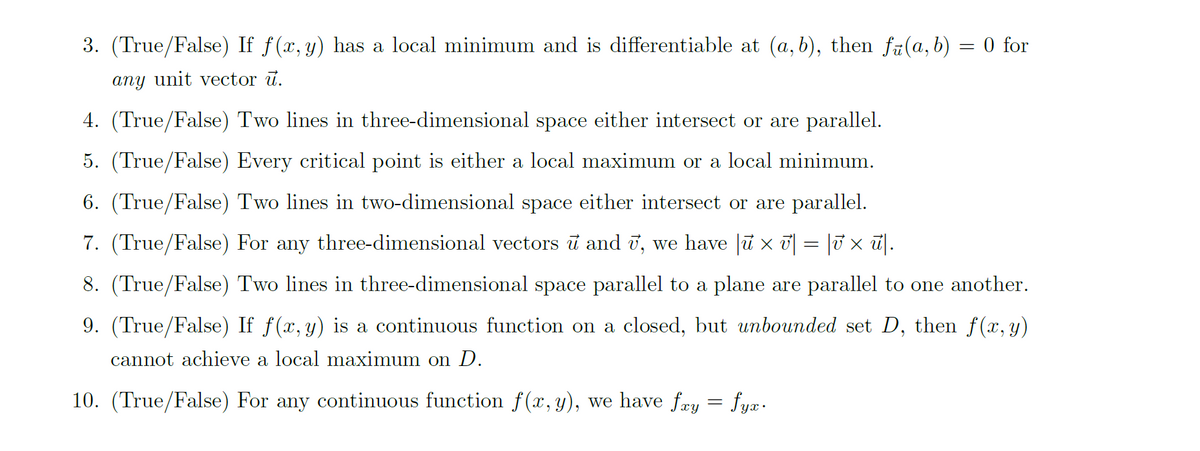3. (True/False) If f(x, y) has a local minimum and is differentiable at (a, b), then fu(a, b) any unit vector u. = 0 for 4. (True/False) Two lines in three-dimensional space either intersect or are parallel. 5. (True/False) Every critical point is either a local maximum or a local minimum.
3. (True/False) If f(x, y) has a local minimum and is differentiable at (a, b), then fu(a, b) any unit vector u. = 0 for 4. (True/False) Two lines in three-dimensional space either intersect or are parallel. 5. (True/False) Every critical point is either a local maximum or a local minimum.
Advanced Engineering Mathematics
10th Edition
ISBN:9780470458365
Author:Erwin Kreyszig
Publisher:Erwin Kreyszig
Chapter2: Second-order Linear Odes
Section: Chapter Questions
Problem 1RQ
Related questions
Question

Transcribed Image Text:= 0 for
3. (True/False) If f(x, y) has a local minimum and is differentiable at (a, b), then fu(a, b)
any unit vector ū.
4. (True/False) Two lines in three-dimensional space either intersect or are parallel.
5. (True/False) Every critical point is either a local maximum or a local minimum.
6. (True/False) Two lines in two-dimensional space either intersect or are parallel.
7. (True/False) For any three-dimensional vectors u and ʊ, we have |ũ × ʊ| = |ʊ × ú|.
8. (True/False) Two lines in three-dimensional space parallel to a plane are parallel to one another.
9. (True/False) If f(x, y) is a continuous function on a closed, but unbounded set D, then f(x, y)
cannot achieve a local maximum on D.
10. (True/False) For any continuous function f(x, y), we have fxy = fyx.
Expert Solution
This question has been solved!
Explore an expertly crafted, step-by-step solution for a thorough understanding of key concepts.
Step by step
Solved in 2 steps with 2 images

Recommended textbooks for you

Advanced Engineering Mathematics
Advanced Math
ISBN:
9780470458365
Author:
Erwin Kreyszig
Publisher:
Wiley, John & Sons, Incorporated

Numerical Methods for Engineers
Advanced Math
ISBN:
9780073397924
Author:
Steven C. Chapra Dr., Raymond P. Canale
Publisher:
McGraw-Hill Education

Introductory Mathematics for Engineering Applicat…
Advanced Math
ISBN:
9781118141809
Author:
Nathan Klingbeil
Publisher:
WILEY

Advanced Engineering Mathematics
Advanced Math
ISBN:
9780470458365
Author:
Erwin Kreyszig
Publisher:
Wiley, John & Sons, Incorporated

Numerical Methods for Engineers
Advanced Math
ISBN:
9780073397924
Author:
Steven C. Chapra Dr., Raymond P. Canale
Publisher:
McGraw-Hill Education

Introductory Mathematics for Engineering Applicat…
Advanced Math
ISBN:
9781118141809
Author:
Nathan Klingbeil
Publisher:
WILEY

Mathematics For Machine Technology
Advanced Math
ISBN:
9781337798310
Author:
Peterson, John.
Publisher:
Cengage Learning,

